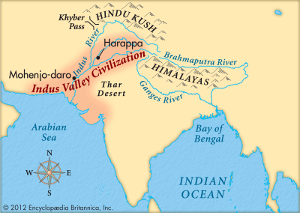|
DNA Links Indus River Valley Civilization to People Today
September 8, 2019
For the first time, scientists have found DNA information from a person known to have lived in the ancient Indus Valley Civilization. The DNA came from a woman who died about 4,500 years ago and was buried in a cemetery near what is now Rakhigarhi, in India, which is not far from the ancient Indus city of Harappa. The DNA showed markers also found in people who live in South Asia today. Further, the scientists said, the genes of the woman were different enough from other nearby cultures like the Fertile Crescent at a time that predates the introduction of agriculture in those regions, suggesting that the woman's civilization had developed farming on its own. This validates what archaeologists had already thought about the Indus River Valley civilization. Also known as the Harappan civilization, this collection of cities and settlements along and near the Indus River, in what is now India and Pakistan, still has something of a mystery about it because although archaeologists have found extensive remains of two major cities and collections of writings from the civilization, the writing remains undeciphered and the civilization, despite at one time being a major trade power, is thought to have met a mysterious end. The Indus River Valley civilization is thought to have been highly advanced. Remains found at Harappa and Mohenjo-Daro, thought to be the two largest cities in the ancient civilization, suggest that the cities were laid out in grids, with straight streets something that other people living at the time in different parts of the world didn't do. Houses were mostly the same in size and shape, and each one had its own well and bathroom, with pipes leading to sewers. Mohenjo-Daro had its own central bath, with several surrounding
buildings. This setup resembles the Roman bath, which came much later. Archaeologiists have found bowls of bronze and silver among the remains of these two great cities. Neither of these metals was available nearby; this suggests that the ancient Indians traded with civilizations far away. |
Social Studies for Kids |
Social Studies for Kids
copyright 2002–2024
David White






